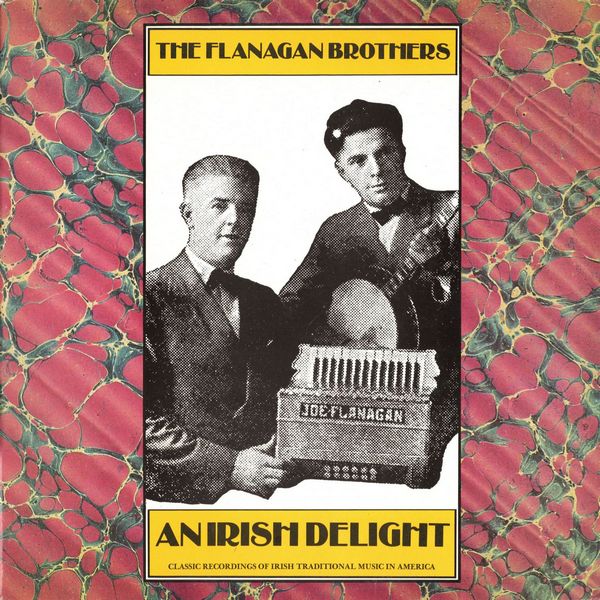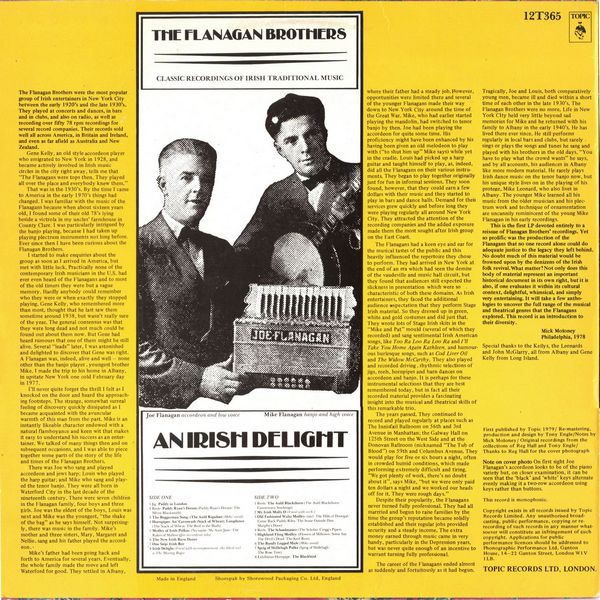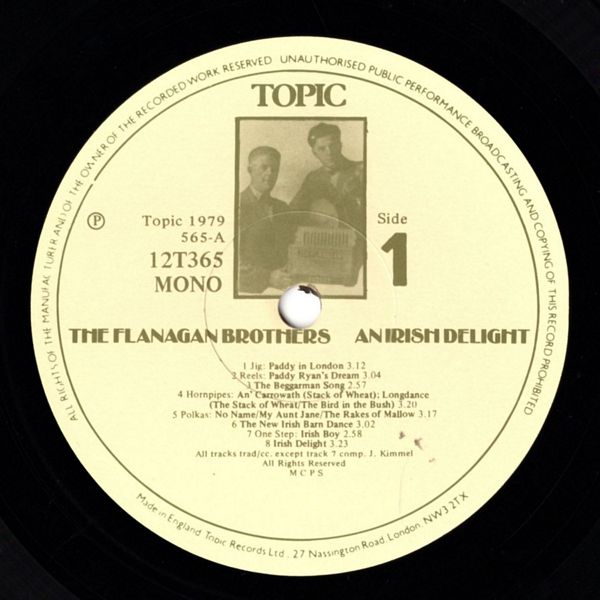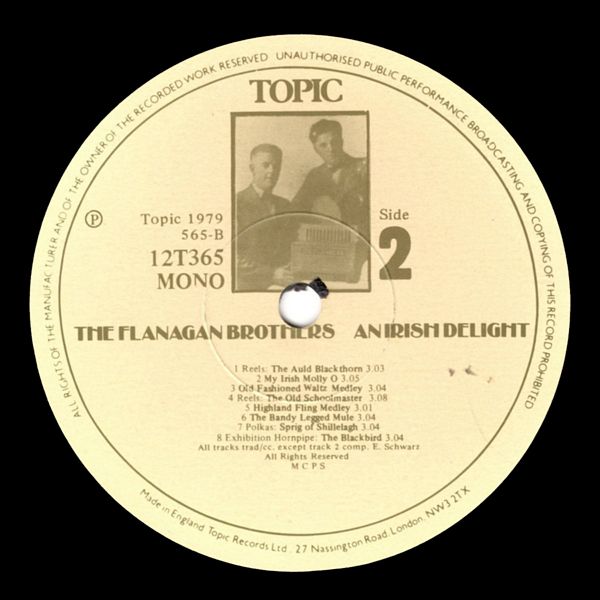
 |


 |
Sleeve Notes
The Flanagan Brothers were the most popular group of Irish entertainers in New York City between the early 1920's and the late 1930's. They played at concerts and dances, in bars and in clubs, and also on radio, as well as recording over fifty 78 rpm recordings for several record companies. Their records sold well all across America, in Britain and Ireland, and even as far afield as Australia and New Zealand.
Gene Kelly, an old style accordeon player who emigrated to New York in 1928, and became actively involved in Irish music circles in the city right away, tells me that "The Flanagans were tops then. They played all over the place and everybody knew them."
That was in the 1930's. By the time I came to America in the early 1970's things had changed. I was familiar with the music of the Flanagans because when about sixteen years old, I found some of their old 78's lying beside a victrola in my uncles' farmhouse in County Clare. I was particularly intrigued by the banjo playing, because I had taken up playing plectrum instruments not long before. Ever since then I have been curious about the Flanagan Brothers.
I started to make enquiries about the group as soon as I arrived in America, but met with little luck. Practically none of the contemporary Irish musicians in the U.S. had ever even heard of the Flanagans and to most of the old timers they were but a vague memory. Hardly anybody could remember who they were or when exactly they stopped playing. Gene Kelly, who remembered more than most, thought that he last saw them sometime around 1938, but wasn't really sure of the year. The general consensus was that they were long dead and not much could be found out about them now. But Gene had heard rumours that one of them might be still alive. Several "leads" later, I was astonished and delighted to discover that Gene was right. A Flanagan was, indeed, alive and well - none other than the banjo player, youngest brother Mike. I made the trip to his home in Albany, in upstate New York one cold February day in 1977.
I'll never quite forget the thrill I felt as I knocked on the door and heard the approaching footsteps. The strange, somewhat surreal feeling of discovery quickly dissipated as I became acquainted with the avuncular warmth of this man from the past. Mike is an instantly likeable character endowed with a natural flamboyance and keen wit that makes it easy to understand his success as an entertainer. We talked of many things then and on subsequent occasions, and I was able to piece together some parts of the story of the life and times of the Flanagan Brothers.
There was Joe who sang and played accordeon and jews harp; Louis who played the harp guitar; and Mike who sang and played the tenor banjo. They were all born in Waterford City in the last decade of the nineteenth century. There were seven children in the Flanagan family, four boys and three girls. Joe was the eldest of the boys, Louis was next and Mike was the youngest, "the shake of the bag" as he says himself. Not surprisingly, there was music in the family. Mike's mother and three sisters, Mary, Margaret and Nellie, sang and his father played the accordeon.
Mike's father had been going back and forth to America for several years. Eventually, the whole family made the move and left Waterford for good. They settled in Albany, where their father had a steady job. However, opportunities were limited there and several of the younger Flanagans made their way down to New York City around the time of the Great War. Mike, who had earlier started playing the mandolin, had switched to tenor banjo by then. Joe had been playing the accordeon for quite some time. His proficiency might have been enhanced by his having been given an old melodeon to play with ("to shut him up" Mike says) while yet in the cradle. Louis had picked up a harp guitar and taught himself to play, as, indeed, did all the Flanagans on their various instruments. They began to play together originally just for fun in informal sessions. They soon found, however, that they could earn a few dollars with their music and they started to play in bars and dance halls. Demand for their services grew quickly and before long they were playing regularly all around New York City. They attracted the attention of the recording companies and the added exposure made them the most sought after Irish group on the East Coast.
The Flanagans had a keen eye and ear for the musical tastes of the public and this heavily influenced the repertoire they chose to perform. They had arrived in New York at the end of an era which had seen the demise of the vaudeville and music hall circuit, but they found that audiences still expected the slickness in presentation which were so . characteristic of both these domains. As Irish entertainers, they faced the additional audience expectation that they perform Stage Irish material. So they dressed up in green, white and gold costumes and did just that. They wrote lots of Stage Irish skits in the "Mike and Pat" mould (several of which they recorded) and sang sentimental Irish American songs, like Too Ra Loo Ra Loo Ra and I'll Take You Home Again Kathleen, and humourous burlesque songs, such as Cod Liver Oil and The Widow McCarthy, They also played and recorded driving, rhythmic selections of jigs, reels, hornpipes and barn dances on accordeon and banjo. It is perhaps for these instrumental selections that they are best remembered today, but in fact all their recorded material provides a fascinating insight into the musical and theatrical skills of this remarkable trio.
The years passed. They continued to record and played regularly at places such as The Innisfail Ballroom on 56th and 3rd Avenue in Manhattan; the Galway Hall on 125th Street on the West Side and at the Donovan Ballroom (nicknamed "The Tub of Blood") on 59th and Columbus Avenue. They would play for five or six hours a night, often in crowded humid conditions, which made performing extremely difficult and tiring. "We got plenty of work, there's no doubt about it", says Mike, "but we were only paid ten dollars a night and we worked our heads off for it. They were rough days."
Despite their popularity, the Flanagans never turned fully professional. They had all married and begun to raise families by the time the group's reputation became solidly established and their regular jobs provided security and a steady income. The extra money earned through music came in very handy, particularly in the Depression years, but was never quite enough of an incentive to warrant turning fully professional.
The career of the Flanagans ended almost as suddenly and fortuitously as it had begun. Tragically, Joe and Louis, both comparatively young men, became ill and died within a short time of each other in the late 1930's. The Flanagan Brothers were no more. Life in New York City held very little beyond sad memories for Mike and he returned with his family to Albany in the early 1940's. He has lived there ever since. He still performs regularly in local bars and clubs, but rarely sings or plays the songs and tunes he sang and played with his brothers in the old days. "You have to play what the crowd wants" he says, and by all accounts, his audiences in Albany like more modern material. He rarely plays Irish dance music on the tenor banjo now, but his unique style lives on in the playing of his protege, Mike Leonard, who also lives in Albany. The younger Mike learned all his music from the older musician and his plectrum work and technique of ornamentation are uncannily reminiscent of the young Mike Flanagan in his early recordings.
This is the first LP devoted entirely to a reissue of Flanagan Brothers' recordings. Yet so prolific was the production of the Flanagans that no one record alone could do adequate justice to the legacy they left behind. No doubt much of this material would be frowned upon by the denizens of the Irish folk revival. What matter? Not only does this body of material represent an important historical document in its own right, but it is also, if one evaluates it within its cultural context, delightful, whimsical, and simply very entertaining. It will take a few anthologies to uncover the full range of the musical and theatrical genres that the Flanagans explored. This record is an introduction to their diversity.
Mick Moloney Philadelphia, 1978